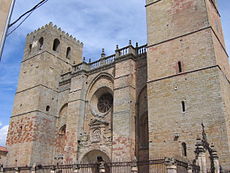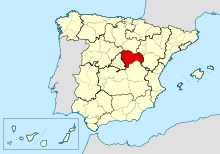Roman Catholic Diocese of Sigüenza-Guadalajara
|
Diocese of Sigüenza-Guadalajara Dioecesis Seguntinus-Guadalaiarensis Diócesis de Sigüenza-Guadalajara |
|
|---|---|

|
|
| Location | |
| Country | Spain |
| Ecclesiastical province | Toledo |
| Metropolitan | Toledo |
| Statistics | |
| Area | 12,190 km2 (4,710 sq mi) |
| Population - Total - Catholics |
(as of 2010) 246,151 221,632 (90%) |
| Information | |
| Denomination | Roman Catholic |
| Rite | Latin Rite |
| Established | 589 (As Diocese of Sigüenza) 9 March 1959 (As Diocese of Sigüenza-Guadalajara) |
| Cathedral | Cathedral Basilica of the Assumption of Our Lady in Sigüenza |
| Co-cathedral | Co-Cathedral of St Mary in Guadalajara |
| Current leadership | |
| Pope | Francis |
| Bishop | Atilano Rodríguez Martínez |
| Metropolitan Archbishop | Braulio Rodríguez Plaza |
| Emeritus Bishops | José Sánchez González Bishop Emeritus (1991-2011) |
| Map | |
 |
|
| Website | |
| website of the diocese | |
The Roman Catholic Diocese of Sigüenza-Guadalajara (Latin: Seguntin(us) – Guadalaiaren(sis)) is a diocese located in the cities of Sigüenza and Guadalajara, Spain in the Ecclesiastical province of Toledo in Spain.
It is in the located in the secular Spanish province of Guadalajara in Castile, central Spain. It is bounded on the north by Soria, on the east by Zaragoza and Teruel, on the south by Cuenca and on the west by Guadalajara and Segovia.
The diocese was established in 589 AD: the fictitious chronicles pretended that St. Sacerdos of Limoges in France had been its bishop; Protogenes was present as Bishop of Sigüenza at the Third Council of Toledo and again the same Protogenes at Gundemar's council in 610; Ilsidclus assisted at the fourth, fifth and sixth councils; Wideric, at the seventh to the tenth; Egica, at the eleventh; Ela, at the twelfth, thirteenth and fourteenth; Gunderic, at the fifteenth and sixteenth. The succession of bishops continued under the Arab domination: after , in 851, we find there Sisemund, a man of great sagacity. But later on Sigüenza was so completely depopulated that it does not appear among the cities conquered by Alfonso VI of Castile (1065-1109) when he subdued all this region. The first bishop of Sigüenza, after it had been repeopled, was Bernardo, a native of Agen in France, who had been "capisol" (caput schola, Latin for school head(master)) of Toledo; he rebuilt the church and consecrated it on the Feast of St. Stephen, 1123, and placed in it a chapter of canons regular; he died Bishop-elect of Santiago. On 14 March 1140, Alfonso VII granted the bishop the feudal lordship of Sigüenza, which his successors retained until the fourteenth century, making the diocese a minor prince-bishopric.
...
Wikipedia
